Google Translate Crowdsourcing
Written on March 26, 2016 – 12:13 pm | by Emily Taylor
I became interested in Google Translate’s crowdsourcing activities when the Google Translate Community Program Manager (who is also a MIIS grad!) came to campus to give a lecture and demonstration on the Google Translate Community.
When you go to translate.google.com, it’s hard to ignore the small banner at the bottom of the page beckoning you to participate. You could be the one watering those plants, helping Google Translate grow!
When you click the “JOIN THE TRANSLATE COMMUNITY” link…
You are taken to this sleek dashboard. Everything is colorful and simple. You can see your stats on the right, and you have two options: translate or validate.
Let’s validate!
Given the source text, we see one or more translations. We have to choose the check mark or the x mark for each one.
Note that Google Translate doesn’t offer any instructions to determine which are correct. While it’s nice to be able to jump right in without having to wade through a style guide, I find myself wondering if sentences that are translated correctly but with punctuation errors deserve a check mark. I arbitrarily decide that missing a final period is okay, but missing an apostrophe (eg, youre instead of you’re) is not. I can’t help wondering what sort of personal rules other users have made.
What sort of quality should I be looking for? Flawless human translation quality? Or translations that correctly convey the meaning? Google Translate doesn’t tell me, so I’m on my own again.
Here, most of these get the point across but fail to reflect the politeness in the original Japanese. I choose the one closest, despite its lack of capitalization and punctuation.
The translations to validate come in bite-sized sets of ten.
What’s that? I’m only one validation away from leveling up? Well… I really should be getting some other things done, but how could I not do one more set?
Some of these options are frustratingly close to a good translation (“I have hay fever.”), but I give them an X for sounding a bit off. I wish there was an option to suggest a better translation.
I level up, and a bright yellow character does a quick dance on the screen to celebrate. How rewarding!
I’m now at Level 10, and I think that’s enough translation validating for today. How about some actual translating?
The translating step is similar – simple and quick. But you don’t get any extra “points” for translating, and validation is faster, so I find myself just wanting to validate other users’ translations.
Now whenever I visit translate.google.com, I see my progress, along with a thank you and an encouragement to keep going.
Google Translate has clearly designed a clever crowdsourcing platform.
- Its sleek and simple interface allows users to start working right away – no learning curve, and no need to slog through a list of rules or through style guides.
- Since the validations and translations come in bite-sized chunks – no more than a single sentence, and often just a phrase – it’s easy to keep going and going.
- Leveling up is fun and addictive. As far as I can tell, the number is meaningless… but I still wanted to get it higher!
Clearly, this system will lend itself to a high quantity of translations and validations, which is exactly what Google Translate needs to continuously improve its machine translation. There were, however, a few aspects that made me less inclined to participate.
- It’s a lot easier to validate than to translate, but both activities are equal in point value. I wanted to actually translate, but my desire to level up kept me in validation mode most of the time. Of course, this is certainly entirely by design. While Google Translate doesn’t publicize how many validations a translation needs to be approved, I’m sure it’s quite a few, perhaps even 100 or more. They need more activity in the validation stage than the translation stage, so it wouldn’t make sense to reward translation activity more, even though it requires more time and effort.
- Overall, the entire process is opaque. While the lack of information and guidance makes for a nice, clean interface, personally, I like to know I’m making a difference. And I found myself wondering – am I making a difference? I wish Google Translate could give me some indication of how or how much I’m helping.
- Despite this being a crowdsourcing effort, I didn’t feel like part of a crowd. In fact, I felt rather lonely. There was no leaderboard or any other way to see other users’ activities, and no forums or way to get to know them. It was fun leveling up, but I’d like to be able to show off my points and have a way to compare my progress to that of others.
Google Translate’s crowdsourcing platform works wonderfully for achieving what they require – a high quantity of translations and an even higher quantity of validations to constantly improve its machine translation. Personally, I prefer to volunteer my translation services to causes that let me see how I am making a difference and where I can truly feel like part of a community, so the Google Translate Community may not be for me.
Google Translate may be sacrificing some quality by excluding translators like me, but they have made the correct choice (quantity over quality) for meeting their translation crowdsourcing goals.

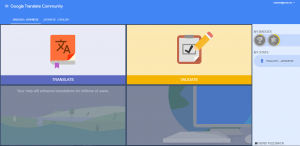
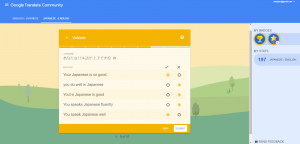
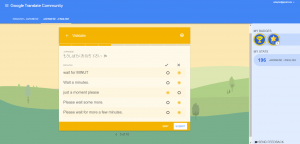
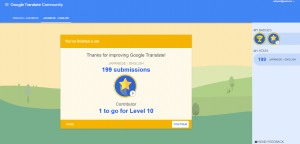
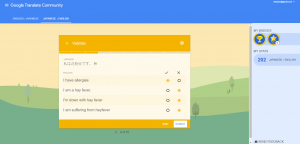
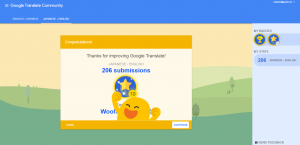
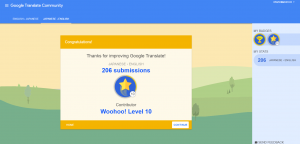
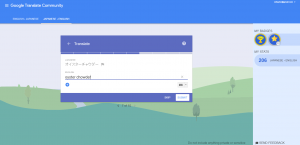
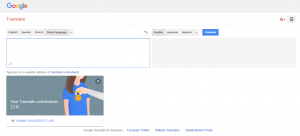


No Responses to “Google Translate Crowdsourcing”